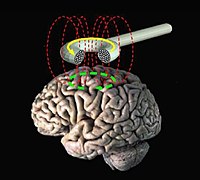
Photo from wikipedia
Transcranial direct current stimulation (tDCS), a form of non‐invasive brain stimulation, is a promising treatment for depression. Recent research suggests that tDCS efficacy can be augmented using concurrent cognitive‐emotional training… Click to show full abstract
Transcranial direct current stimulation (tDCS), a form of non‐invasive brain stimulation, is a promising treatment for depression. Recent research suggests that tDCS efficacy can be augmented using concurrent cognitive‐emotional training (CET). However, the neurophysiological changes associated with this combined intervention remain to be elucidated. We therefore examined the effects of tDCS combined with CET using electroencephalography (EEG). A total of 20 participants with treatment‐resistant depression took part in this open‐label study and received 18 sessions over 6 weeks of tDCS and concurrent CET. Resting‐state and task‐related EEG during a 3‐back working memory task were acquired at baseline and immediately following the treatment course. Results showed an improvement in mood and working memory accuracy, but not response time, following the intervention. We did not find significant effects of the intervention on resting‐state power spectral density (frontal theta and alpha asymmetry), time–frequency power (alpha event‐related desynchronisation and theta event‐related synchronisation) or event‐related potentials (P2 and P3 components). We therefore identified little evidence of neurophysiological changes associated with treatment using tDCS and concurrent CET, despite significant improvements in mood and near‐transfer effects of cognitive training to working memory accuracy. Further research incorporating a sham‐controlled group may be necessary to identify the neurophysiological effects of the intervention.
Journal Title: European Journal of Neuroscience
Year Published: 2019
Link to full text (if available)
Share on Social Media: Sign Up to like & get
recommendations!